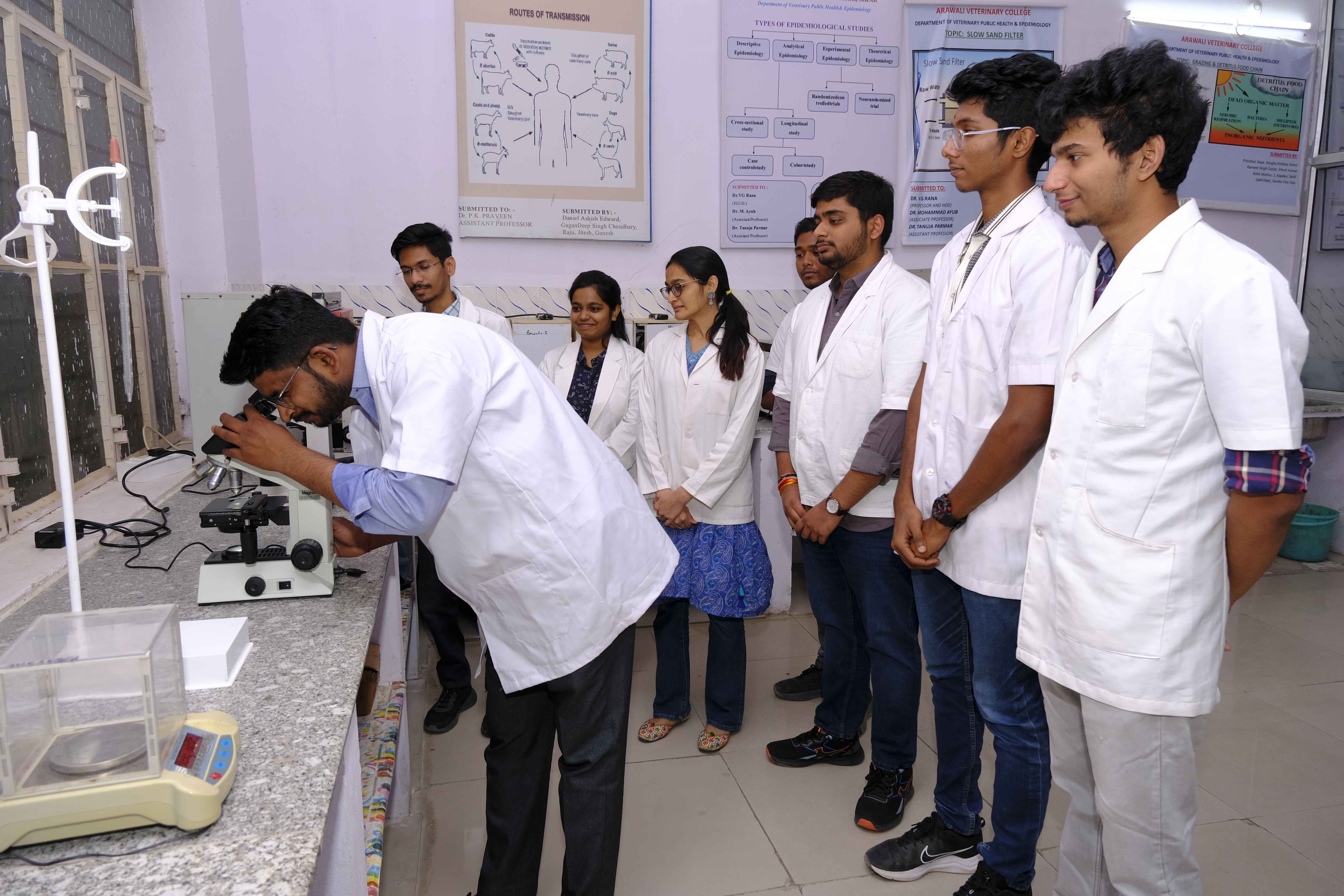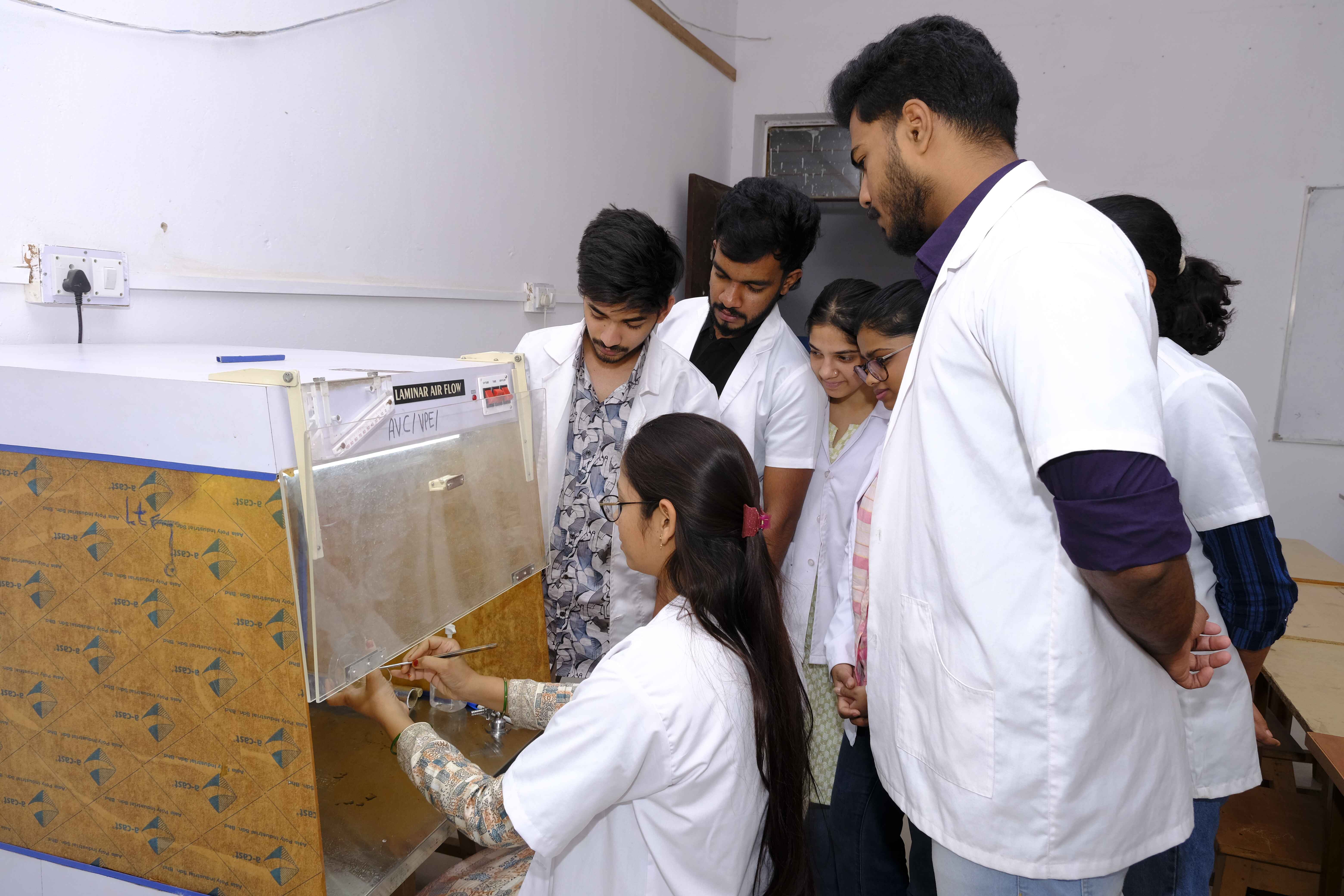

Department of Veterinary Public Health and Epidemiology imparts education and practical training on role of a veterinarian various aspects of hygiene, public health administration, zoonotic diseases, food borne infections, epidemiological surveys, environment preservation, one health concept, etc. Practical training is given on physical, chemical, microbiological, serological or hypersensitivity tests for diagnostic procedures.
The Department has following sanctioned strength of Faculty:
Professor - 1
Associate Professor – 1
Assistant Professors – 1
S.No.
|
Name
|
Designation
|
Qualification
|
Service Period at AVC
|
Photo
|
Biodata |
|
01
|
Dr. Mohammed Ayub
|
Associate Professor
|
B.Sc & AH, M.V.Sc
|
18.06.2021 to till Continue
|
 |
Biodata |
|
02
|
Dr. Manoj Kalwaniya
|
Assistant Professor
|
B.V.Sc & AH, M.V.Sc and PhD
|
01.11.2023 to till Continue
|
 |
Biodata |
COURSES AND SYLLABI
THEORY
UNIT-1 (VETERINARY PUBLIC HEALTH AND FOOD SAFETY)
Aims and scope of Veterinary Public Health. Role of veterinarians in public health. One Health concept and initiatives. Veterinary Public Health administration. Sources of contamination. Principles and concepts of food hygiene and safety. Milk hygiene in relation to public health. Hygienic and safe milk production practices including steps for prevention and control of milk contamination, adulterants, antimicrobial residues, agrochemicals, subclinical mastitisorudder infections etc. Microbial flora of milk and milk products. Milk plant and dairy equipment hygiene. Quality control of milk and milk products. Milk hygiene practices in India and other countries. Elements of meat inspection and meat hygiene practices. Pathological conditions associated with the transport of food animals. Hygiene in abattoirs and meat plants. Detection of conditionsor diseases and judgements during ante mortem and post mortem inspection. Examination of lymph nodes. Meat as a source of disease transmission. Sources of contamination of meat and methods of carcass decontamination. Speciation of meat. Animal welfare and public health issues. Classification of low risk and high risk material generated in an abattoir and its hygienic disposal. Inspection of poultry for human consumption. Occupational health hazards in abattoir and meat plants. Foodborne infections and intoxications associated with foods of animal origin. Toxic residues (pesticides, antibiotics, metals and hormones) in foods and associated health hazards. Types of biohazards. Hazard analysis and critical control points (HACCP) system. Importance of ISO 9000 and 14000 series in meat industry. Risk analysis, assessment and management. International food safety standards: World Organisation for Animal Health (OIE), World Trade Organization (WTO) agreements and Codex Alimentarius Commission. Sanitary and phytosanitary measures in relation to foods of animal origin. Food Safety and Standards Act and Regulations. Role of Food Safety and Standards Authority of India (FSSAI), Bureau of Indian Standards (BIS) and other national agencies.
UNIT-2 (VETERINARY EPIDEMIOLOGY)
Definitions, components and aims of epidemiology. Factors influencing occurrence of livestock diseases and animal production. Determinants of disease. Transmission and maintenance of infections. Ecology of disease. Measures and patterns of disease occurrence. Survey and surveillance of animal diseases and related parameters. Epidemiological methods- Descriptive, analytical, experimental, theoretical, serological and molecular. Animal disease forecasting. Strategies of disease management: prevention, control and biosecurity. Economics of animal diseases. National and international regulations on livestock diseases. Role of OIE and laws on international trade of animals and animal products.
UNIT-3 (ZOONOTIC DISEASES)
Definition, history and socio-economic impact of zoonotic diseases. Classification of zoonoses and approaches to their management. Multisectoral approach for zoonoses prevention and control. Emerging, re-emerging and occupational zoonoses. Role of domestic, wild, pet and laboratory animals and birds in transmission of zoonoses. Zoonotic pathogens as agents of bioterrorism. Epidemiology, clinical manifestations and management of the following zoonoses: Rabies, Japanese encephalitis, influenza, Kyasanur forest disease, Crimean Congo haemorrhagic fever, Nipah encephalitis, Ebola virus infection, anthrax, brucellosis, tuberculosis, leptospirosis, listeriosis, plague, glanders, Q fever, rickettsiosis, chlamydiosis, taeniasis, cysticercosis, hydatidosis, larva migrans, diphyllobothriasis, trichinellosis, toxoplasmosis, fasciolosis, paragonimiasis, sarcocystosis, cryptosporidiosis, amoebiasis, giardiasis, leishmaniasis, superficial and systemic mycosis and prion diseases. Foodborne bacterial zoonoses: salmonellosis, E. coli infection, staphylococcal gastroenteritis, clostridial food poisoning, campylobacteriosis etc.
UNIT-4 (ENVIRONMENTAL HYGIENE)
Scope and importance. Ecosystem: Components structure and functions. Biodiversity: uses, threats and conservation. Natural resources: types, uses and abuses. Environmental contaminants in food chain-bioaccumulation, biomagnification and persistent organic pollutants. Environmental pollution: Sources, nature of pollutants, effects on animal and human health. Rural and urban pollution. Air pollution, sources and hazard. Air pollution in animal houses, effect on health and productivity. Airborne diseases – Classification, health hazard, prevention and control. Water-Sources, contamination & their prevention. Water qualities- Physical, chemical, bacteriological and radiological. Water purification methods for community water supplies. Waterborne diseases – Classification, health hazard, prevention and control. Soil, marine and thermal pollution- Classification, sources, hazard, prevention and control. Noise pollution – Sources, hazards, prevention and control. Nuclear hazardsor radiological hazard-Types, hazards and radiation protection. National rules and legislations related to environmental pollution and role of pollution control board in India. Biosafety: Importance, classification and biosafety measures for prevention of risk hazards. Disaster management and mitigation. Solid and liquid waste management at farms and biomedical waste management. Sanitation and disinfection of farm and hospital environment in veterinary public practice for infection control. Global warming and greenhouse effect- Definition, greenhouse gases, impact of climate change and international treatiesorprotocols. Management of waste from animal industries. Stray and fallen animal management and carcass disposal. Vector and reservoir control.
PRACTICAL
UNIT-1 (VETERINARY PUBLIC HEALTH AND FOOD SAFETY)
Collection of samples for chemical and bacteriological examination. Grading of milk by dye reduction test, direct microscopic examination and standard plate count. Quality assurance tests for processed milk and milk products. Tests for plant sanitation-Air, water and equipment. Microbiological examination of raw milk, pasteurized milk, milk products, meat, meat products and eggs-standard plate count, coliform count, enterococcal count, psychrophilic and psychrotophic organisms, thermophilic bacteria and yeast and mold count. Detection of organisms of public health significance from food products by techniques. Tests for detection of mastitic milk. Ante-mortem and post-mortem inspection of food animals. Demonstrationordetection of toxic chemicals and contaminants of public significance from milk and meat. Detection of antimicrobial residues in milk and meat by microbiological and analytical techniques. Demonstration of speciation of meat.
UNIT-2 (VETERINARY EPIDEMIOLOGY)
Sampling methods for epidemiological studies. Measurement of disease frequencies. Sources, storage, retrieval and representation of disease informationordata. Demonstration of selected software programmesor models. Evaluation of sensitivity and specificity of diagnostic tests by epidemiological methods. Determination of associations of disease and hypothesized causal factors. Survey of an animal disease on a farm. Epidemiological investigation of disease outbreaks.
UNIT-3 (ZOONOTIC DISEASES)
Detection, isolation and identification of important pathogens of zoonotic importance from animal, human and environmental sources including foods of animal origin. Detection of zoonotic diseases by serological, molecular and hypersensitivity tests. Study of probable association of human diasease conditions with animal diseases present in an area. Study of rural environment and health status of rural community.
UNIT-4 (ENVIRONMENTAL HYGIENE)
Sampling methods for testing quality of air, water, soil and other environmental sources. Physical, chemical and microbiological examination of water. Estimation of residual chlorine and chlorine demand. Isolation & identification of pathogens from air, water and other environmental sources. Disinfection of animal houses. Determination of efficacy of disinfectants – Phenol coefficient, MIC and MBC. Demonstrationorvisit to water purification system. Demonstration of various ventilation systems in animal houses and specialized laboratories. Demonstration of toxic residues in water and other environmental sources. Visit to local polluted site and documentation of local environmental problems – like dumping grounds, local slum areas, crowded localities etc.
ANNUAL EXAMINATION
PAPERS UNITS MAXIMUM MARKS WEIGHTAGE
THEORY
Paper-I 1 and 2 100 20
Paper-II 3 and 4 100 20
PRACTICAL
Paper-I 1 and 2 60 20
Paper - II 3 and 4 60 20
INTEARNAL ASSESSMENT 20